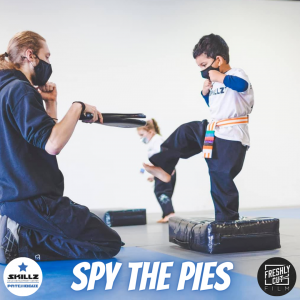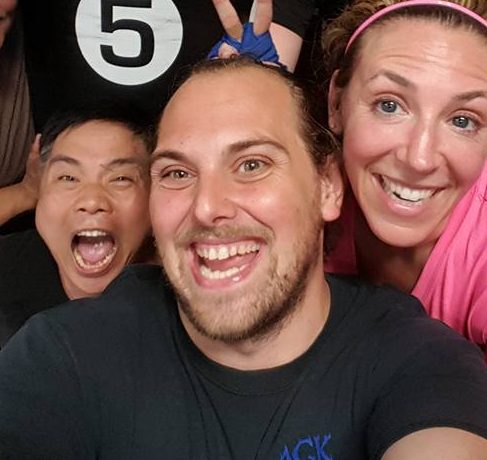In our SKILLZ child development classes, we use martial arts as a tool to help kids connect with the powerful lessons that give them an unfair developmental advantage.
Each activity is specifically designed to target one or more of these areas of development. We use the acronym PIES to describe these aspects of a child’s growth:
- Physical – This includes all aspects of a child’s interaction with the physical world, muscular development, and kinesthetic awareness. While most of our students have perfectly healthy young bodies, it is not uncommon for kids to feel challenged physically as they change and grow.
- Intellectual – This area of development draws a lot from the latest research in neuroscience. This includes things like working on improving a child’s speed of processing, increasing their cognitive load, and improving their awareness of how their decisions affect the outcomes.
- Emotional – Kids face big emotions. Our classes support their emotional intelligence by helping them label those emotions and provide tools for kids to self-regulate and overcome the “downstairs” emotional brain so they can stay cool, calm, and successful.
- Social – we recognize that, at each stage of development, kids experience social situations differently. Our goal is to help them become active members of their social group while maintaining a well-defined self-identity and strong personal boundaries.
(Bonus: a fifth developmental focus is language skills, which we actively include in our intellectual training)
Take a look at this picture of 3-year-old Bradley working on his kicks with Mr. Robert in our Early SKILLZ class:

Bradley thinks he is learning how to be a NINJA!
But…
Can You Spy All Four PIES?
In this drill, named Happy Feet, students have to wait for the prompt, then step onto the pad as quickly as possible without falling over. Once they have their balance, each student throws two kicks as the instructor counts. Finally, they jump off the pad and land with good balance.
Can you name one thing Bradley is working on physically, intellectually, emotionally, or socially?
Physically
Bradley is working on several skills related to his physical development. For example, he is actively developing his sense of proprioception, which is the body’s awareness of the position of its parts in relation to one another, and his ability to balance (vestibular system). This includes strengthening his stabilizer muscles, developing eye-foot coordination, and learning how to apply and control force in his movements.
Intellectually
Bradley is learning how to follow multiple-step commands, which is related to the principle of cognitive load. At 3 years old, a typical child can follow a two-step command but will struggle with more complex instructions.
Believe it or not, he is also exploring advanced physics as he calculates the amount of force needed to hop a specific distance with a specific trajectory; this is his spatial awareness skill. As mentioned above, as a bonus, he is also improving his language skills as he practices the prepositions “in front” and “behind.”
Emotionally
Bradley is working on his ability to regulate his emotions by moderating his excitement about hopping and kicking. Children at this age will often become excited to try new things but struggle with listening to instructions as their emotions take over.
The same idea is being applied to his fear of falling over; as he works through the challenge and builds competence, his self-efficacy (belief in his abilities) increases, which allows him to process at a more rational level instead of being ruled by the strong fear emotion.
Socially
Bradley is learning about taking turns, which is above the expected stage of development for a child his age. Preschoolers are often more interested in a parallel play model, which means they play alongside their peers, often participating in the same activity, but just as often with minimal interaction. He is learning about working with a partner to achieve a goal (usually expected of a 5 to 6-year-old child) and practicing how to be encouraging toward his peers.
The Martial Arts Vehicle
No, not the Ninjamobile!
If we brought the kids into yet another classroom, with yet another set of adults talking about yet another set of facts to learn, they would quickly disengage. By using a tool such as martial arts, we help the kids engage in their own learning. We do this by supporting the secretion of the body’s feel-good chemicals: the neurotransmitters that reinforce a positive learning experience.
According to Brain Gym founder Paul E. Dennison, “Movement is the door to learning.”
When children engage physically through movement, they have a chance to understand very high concepts viscerally. The same way you can make swish a basketball without running the calculations on a blackboard, a child can inherently understand high-level concepts when they have a chance to move through an activity. This movement also encourages the secretion of endorphins, which provide a pleasant sense of accomplishment.
By providing a nurturing environment with instructors who are specifically trained in the expectations of each stage of development and the associated theories of motivation, children learn to bond with and feel safe in the presence of their mentors. When a child likes you, the desire to learn from you increases. These close bonds foster the secretion of oxytocin, which is the trust chemical. If a child feels safe, a child can shift attention to learning.
Each part of each class has a clearly defined set of challenging yet achievable goals. Through the use of edutainment (the interweaving of education and entertainment), kids face these challenges as they would face a new level of a video game: with excitement! When kids laugh and have fun, their bodies secrete serotonin, which contributes to a general sense of well-being that they associate with the learning environment.
With achievement comes recognition. Through the careful inclusion of both intrinsic and extrinsic motivators, kids learn to anticipate each lesson’s challenges. This anticipation and the success that follows lead dopamine production, which is the body’s reward chemical. When kids feel a sense of reward, they look for ways to continue the activities that made them successful.
When we talk about these four neurotransmitters — Dopamine, Oxytocin, Serotonin, and Endorphins — and the ways in which we leverage them in the learning environment, we call it the DOSE method. When combined with the PIES concept, even a simple activity such as hooping on a pad and throwing kicks becomes a powerful tool that gives kids an unfair developmental advantage.
To learn more about the powerful Skillz child development program that uses elements of martial arts training as the vehicle for growth, or to get your child started at our Patchogue location, click the button below:
VISION MARTIAL ARTS
218 Medford Ave
Patchogue, NY 11772

Author: Michael A Evans
Michael is a 6th-degree black sash under his teacher, Moises Arocho, and has been training in martial arts since 1985. Michael has a degree in Massage Therapy from NY College of Health Professions. He is the co-owner of Vision Martial Arts in Patchogue, NY. Michael is also the Lead Consultant for Skillz Worldwide.
Special thanks to Freshly Cut Film for the great pic!

















